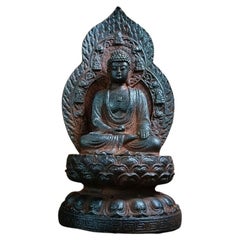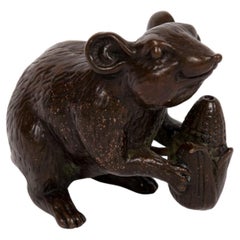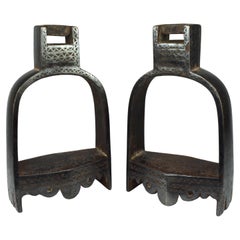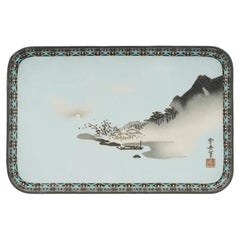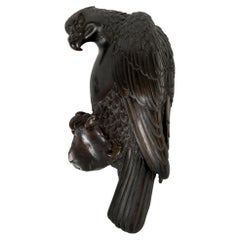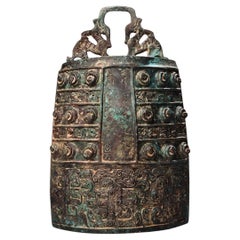Metalwork
to
116
445
388
946
86
42
11
3
1
1
1
128
946
842
28
434
177
55
39
12
18
7
12
7
21
9
5
2
934
311
221
183
166
705
531
350
163
84
946
946
946
14
4
4
3
3
Metalwork For Sale
Period: 19th Century
Period: Late 19th Century
Vintage Chinese Iron Buddha Statue Sitting on Lotus
Located in 景德镇市, CN
This Vintage Chinese Iron Buddha Statue beautifully captures the serene presence of the Buddha seated gracefully atop a lotus flower, a powerful symbol of purity, enlightenment, and ...
Category
19th Century Antique Metalwork
Materials
Iron
Japanese Bronze sculpture of a Mouse holding a korn knob
Located in PARIS, FR
An interesting bronze sculpture of a seated mouse holding a small corn knob. Realistic treatment of the fur, eyes, hears nose and mouth, its tail is curving on the left side of the s...
Category
Late 19th Century Japanese Meiji Antique Metalwork
Materials
Bronze
Pair of Metal Mughal Horse Stirrups with Silver Inlay, 19th Century
Located in Islamabad, PK
Thepair of metal Mughal horse stirrups with silver inlay, dating back to the 19th century, are astriking example of equestrian equipment reflecting the ar...
Category
19th Century Indian Anglo Raj Antique Metalwork
Materials
Metal, Silver
Japanese Wireless Cloisonné Serving Tray Meiji After Namikawa Sosuke
Located in New York, NY
A rare 19th Century Japanese copper serving tray with cloisonne enamel design. The central part of the tray depicts a wireless cloisonne picture, a coastal landscape view with a full moon. The hieroglyphical signature of the artist is in the lower right. The rims and the backside are decorated with floral ornaments. Blue and black color palette. Collectible Oriental Decor And Applied Arts For Interior Design.
Namikawa Sosuke (1847–1910) was a Japanese cloisonné artist,[1] known for innovations that developed cloisonné enamel into an artistic medium sharing many features with paintings.[2][3] He and Namikawa Yasuyuki (no relation)[notes 1] were the most famous cloisonné artists of the 1890 to 1910 period, known as the "golden age" of Japanese enamels.[1] Around 1880 he set up and ran the Tokyo branch of the Nagoya Cloisonné Company.[1] He exhibited his artworks at national and international expositions, where he took an organising role.[2] He was recognised as an Imperial Household Artist and created art works for imperial residences. He sometimes signed his works with the character sakigake (Pioneer)
the art work is based off a art work done by Sesshu Toyo
Sesshu Toyo (?? ??, c. 1420 – August 26, 1506), also known simply as Sesshu (??), was a Japanese Zen monk and painter who is considered a great master of Japanese ink painting. Initially inspired by Chinese landscapes, Sesshu's work holds a distinctively Japanese style that reflects Zen Buddhist aesthetics.[1] His prominent work captured images of landscapes, portraits, and birds and flowers paintings, infused with Zen Buddhist beliefs, flattened perspective, and emphatic lines.[2]
Sesshu was born into the samurai Oda family (???) and trained at Shokoku-ji temple in Kyoto, Japan, as a Zen monk.[1] From his early childhood, Sesshu showed a talent for painting and eventually became widely revered throughout Japan as a wise, reputable Zen scholar, and the greatest painter priest of Zen-Shu.[3]
Sesshu worked in a painting atelier whilst training under Tensho Shubun (c. 1418–1463). But upon visiting China, his work betook a distinctive Chinese influence, merging Japanese and Chinese styles to develop his individualistic style of Zen paintings.[3] Sesshu's influence on painting was so wide that many schools of art appointed him their founder.[4] Sesshu's most acclaimed works are Winter Landscape (c. 1470s), Birds and Flowers (1420–1506) and Four Landscape Scrolls...
Category
Late 19th Century Japanese Antique Metalwork
Materials
Copper, Enamel
Ikebana in bronze of an Hawk designed to display flowers hanged on the wall
Located in PARIS, FR
Bronze intentded for hanging (銅掛斜生, dô kakenanaike, « hanging bronze ») depicting a hawk, placed on a branch. The inside is hollow so a bouquet a flowers can be put inside and thus, ...
Category
Late 19th Century Japanese Meiji Antique Metalwork
Materials
Bronze
27cm Old Bronze Chime Bell
Located in 景德镇市, CN
Old Asian Bronze Chime Bell – A Timeless Symbol of Harmony and Tradition
This Old Asian Bronze Chime Bell is a beautifully crafted piece of tradition...
Category
19th Century Antique Metalwork
Materials
Bronze
Antique Japanese Meiji Bronze Tray with Dragon Motif and Bamboo-Style Edges
Located in Kastrup, DK
Bronze Tray from the Meiji Period (1868-1912), Japan.
A high-quality bronze tray featuring a finely detailed relief dragon motif in the center, expertly patinated in silvery and lig...
Category
Late 19th Century Japanese Meiji Antique Metalwork
Materials
Bronze
Lovely antique George III copper kettle
Located in Ipswich, GB
Lovely antique George III copper kettle having a quality copper antique George III kettle with a shaped handle to the top, a shaped spout, with a hinged lid and the original knob.
D...
Category
Early 19th Century George III Antique Metalwork
Materials
Copper
Outstanding Meiji Period Mixed Metal Bell Casket by the Nogowa Foundary
Located in Lymington, Hampshire
Of typical form with a shibuichi ground worked in shakudo, silver and gold with a central continuous frieze showing a 3-toed dragon amongst roiling clouds and spume-flecked waves, the shoulders with fields of shakudo bosses between triple vertical lines, the knop formed by paired dragons...
Category
Late 19th Century Japanese Antique Metalwork
Materials
Metal
Small Antique Octagonal Dish, Middle Eastern, Decorative, Bronze Tray, Georgian
Located in Hele, Devon, GB
This is a small antique octagonal dish. A Middle Eastern, decorative bronze tray with relief decor in Persian taste, dating to the Georgian period, circa 1800.
Unusual and delightfu...
Category
Early 19th Century Asian Georgian Antique Metalwork
Materials
Bronze
Chinese Export Silver Goblet
Located in London, GB
Chinese Export Silver Goblet, with prunus decoration. The goblet weighs 258g and dates from around 1885. Marked WH for Wang Hing '宏兴‘ whi...
Category
1880s Chinese Chinese Export Antique Metalwork
Materials
Silver
Opium Wieght in the Form of a Buddhist lion
Located in PARIS, FR
Tiny opium weight in bonze with brownish patina in the shape of a Buddhist guardian lion, also name Fo dog, characteristic with its exorbitated eyes and an embossed and wavy mane and...
Category
Late 19th Century Cambodian Folk Art Antique Metalwork
Materials
Bronze
Pair 19th Century Chinese Lead Vases Inlayed with Bronze Lamps
Located in Hudson, NY
This pair of vases are from China. Made as part of a 19th century alter garniture set the pair are now lamps. Cast in lead which has been inlayed with bronze decorative elements incl...
Category
1880s Chinese Archaistic Antique Metalwork
Materials
Bronze, Lead
A Japanese drop-shaped bronze vase with a majestic bear in relief
Located in Milano, IT
Japanese drop-shaped bronze vase worked with a remarkable depth that transforms the work into a breathtaking three-dimensional scene with a majestic bear in relief in the center as i...
Category
Mid-19th Century Japanese Antique Metalwork
Materials
Bronze
19th century Chinese bronze cencer with Buddhist lion decoration circa 1860
Located in Central England, GB
This large Chinese bronze censer dates to circa 1860. It is made in three parts, stand, vessel, and lid. The lid has pierced decorative panels with pine trees and a bold Buddhist lion finial for lifting.
The censer has lifting handles in the shape of bamboo to each side and again also has panels with pine forests with mythical beasts and side mounts in the form of Buddhist lion mastheads.
It is raised on four shaped legs with a beast mask head at the top and sits on the raised and pierced stand.
The decoration on this piece is all hand finished with chasing and engraving giving good detail.
The censer has a green/brown patina. Circa 1860
Censers are a type of vessel for burning incense. In many cultures burning incense has spiritual and religious connotations which influence the design and decoration of the censer.
The lion is one of Buddhism’s most potent symbols. Traditionally the lion is associated with regality, strength and power. It is therefore an appropriate symbol of Buddha who, tradition has it, was a regal prince. As Buddhist priests and monks from India, they brought with them stories of stone Asiatic lions...
Category
Mid-19th Century Chinese Chinese Export Antique Metalwork
Materials
Bronze
Chinese Qing Twin Handled Miniature Bronze Tripod Censer
Located in Bishop's Stortford, Hertfordshire
A stylish and heavily made antique Chinese Qing (1644-1911) twin handled bronze tripod censer dating from the 18/19th century. The censer stands raised on three simply formed legs wh...
Category
19th Century Chinese Qing Antique Metalwork
Materials
Bronze
Antique Early Meiji Japanese Cloisonne Goldstone Enamel Double Dragon Lidded Jar
Located in New York, NY
Antique Early Meiji Japanese Cloisonne Goldstone Enamel Double Dragon Lidded Jar
An antique Japanese copper ginger jar with polychrome cloisonne enamel design. Early Meiji period, ca...
Category
Late 19th Century Japanese Meiji Antique Metalwork
Materials
Copper, Enamel
A Large Meiji Period Bronze Temple Lantern
Located in Lincolnshire, GB
A 19th century Japanese Bronze temple lantern decorated with finely cast animals and bells. The pagoda top above the open fret work lantern section with a door that opens.
Circa 1880
Category
Late 19th Century Japanese Meiji Antique Metalwork
Materials
Bronze
Antique 19th Century Indian Kutch Solid Silver Mug, Oomersi Mawji Bhuj c.1890
Located in Royal Tunbridge Wells, Kent
Antique 19th Century Indian Kutch (Cutch) solid silver mug. This exceptionally fine tapered mug is finely decorated throughout with intricate floral repoussé work set against a finel...
Category
19th Century Indian Other Antique Metalwork
Materials
Silver
Chinese Antique Iron Bath
Located in Leamington Spa, Warwickshire
Interesting 19th C Chinese antique iron bath. 1860.
Dimensions
41 inches (104 cms) Wide
25.5 inches (65 cms) Deep
18 inches (46 cms) High.
Category
19th Century Chinese Antique Metalwork
Materials
Iron
A Japanese patinated bronze vase depicting a cricket
Located in Milano, IT
A slender shape patinated bronze vase depicting a naturalistic scene of a cricket sitting on iris leaves.
Signed Joun in relief within an oval reserve.
Origin: Japan
Period: Meiji ...
Category
Late 19th Century Japanese Japonisme Antique Metalwork
Materials
Bronze
Chinese Export Silver Goblet
Located in London, GB
A Chinese silver goblet profusely decorated with chased, richly defined chrysanthemum against a matte background and is supported by two intertwi...
Category
1890s Chinese Chinese Export Antique Metalwork
Materials
Silver
Old Chinese Bronze High-Heeled Incense Burner
Located in 景德镇市, CN
This Old Chinese Bronze High-Heeled Incense Burner is a unique and elegant piece of traditional craftsmanship, combining artistic design with spiritual significance. Crafted from sol...
Category
19th Century Antique Metalwork
Materials
Bronze
Hindu bronze sculpture of Shiva. Probably 19th C.
Located in Copenhagen, DK
Hindu bronze sculpture of Shiva.
Probably 19th century.
In excellent condition with good patina., broken belly band. See photo 3.
Dimensions: W 24.0 cm. x...
Category
19th Century Indian Antique Metalwork
Materials
Bronze
19th Century Japanese Cast Bronze + Rattan Geisha Mirror Mating Cranes Edo Kanji
Located in Hyattsville, MD
Wonderful nature scene of two mating cranes. Heavy bronze mirror. Present as-found and unpolished. Unmarked, but with Kanji title in artwork. Weighing just over 4 lbs.
Category
19th Century Anglo-Japanese Antique Metalwork
Materials
Bronze
A Japanese Meiji Period Patinated Bronze Centerpiece/Bowl w/ Dragon in Relief
Located in New York, NY
A Fantastic and large Japanese Meiji Period Patinated Bronze Centerpiece/Bowl/jar denier with Dragon in Relief. This captivating and exquisite, hand-crafted, patinated bronze centerpiece serves as a remarkable focal point, adorned with marvelously hand-chassed and hand-chiseled dragons in relief, gracefully emerging and disappearing behind artfully stylized scrolling etched clouds. The centerpiece boasts a substantial and graceful curved base, complemented by a striking peaked and square-edged lip atop the vessel.
The significance behind the depiction of the three-clawed dragons stems from the Japanese belief that Eastern dragons originated within their native land. According to their folklore, as these majestic creatures ventured away from Japan, they acquired additional toes. The Japanese Sky dragon...
Category
1890s Japanese Meiji Antique Metalwork
Materials
Bronze
Large 24" 19th Century Japanese Cloisonne Vase - Antique Oriental Decor
Located in Wisbech, Cambridgeshire
Antique 19th Century Oriental Japanese Cloisonné Vase - Impressive Large Piece!
This stunning cloisonné vase from the 19th century boasts remarkable craftsmanship and intricate deta...
Category
19th Century Japanese Antique Metalwork
Materials
Stone, Brass, Bronze, Enamel
Antique Japanese Meiji Era (c1880) Cloisonné Vase Phoenix & Dragon 8”
Located in Portland, OR
Available from Shogun's Gallery in Portland, Oregon for over 40 years specializing in Asian Arts & Antiques.
This is a beautiful Japanese Meiji era (c. 1870-90's) ornate cloisonné v...
Category
Late 19th Century Japanese Antique Metalwork
Materials
Copper, Enamel
Japanese Silver Repousse Iris Vase Meiji Period
By Samurai Shokai
Located in Sarasota, FL
Japanese silver repousse vase finely decorated with blown out iris flowers. It is of the Meiji period, circa 1890s. The vase is 5 1/4" tall and weighs 4....
Category
19th Century Japanese Antique Metalwork
Materials
Silver
A pair of bronze vases with Onagadori roosters
Located in Milano, IT
Pair of bronze vases adorned with inlays, decorated with two Onagadori roosters, known for their elegant length of tail. The roosters are represented perched on a plum branch.
Signe...
Category
Late 19th Century Japanese Japonisme Antique Metalwork
Materials
Bronze
Chinese Export Silver Bowl
By Luen Wo
Located in London, GB
Chinese Export Silver Bowl, profusely decorated with chrysanthemum, prunus, iris, and bamboo, and with a vacant circular cartouche. The bowl d...
Category
Late 19th Century Chinese Chinese Export Antique Metalwork
Materials
Silver
Japanese Meiji Cloisonne Lidded Jar Decorated with Flowers & Butterflies
Located in Bishop's Stortford, Hertfordshire
A very fine Japanese Meiji cloisonne lidded jar decorated with butterflies amidst bamboo and flowering shrubs dating from the latter 19th Century...
Category
19th Century Japanese Meiji Antique Metalwork
Materials
Metal
Pair of Japanese Bronze Grasshopper Vases
Located in PARIS, FR
Insects (mushi) occupy an important place in Japanese culture. Hunting for insects is a popular pastime, especially among children. Using plastic nets and cages, they catch cicadas and beetles to observe them.
Between 1830 and 1832, Hokusai composed an untitled series of ten large horizontal prints...
Category
Late 19th Century Japanese Antique Metalwork
Materials
Bronze
An Indian part-gilt silver-clad ceremonial sceptre or mace with a tiger’s head
Located in Amsterdam, NL
Northern India or Deccan, late 19th century
L. approx. 82 cm (excl. stand)
Provenance:
Private collection, United Kingdom
This remarkable gilt-silver soonta (ceremonial sceptre) also known as choba (ceremonial mace) with a tiger's head stands out as an unparalleled example. It has a wooden base, clad with thick sheet part-gilt silver and has fine details such as teeth and a curling tongue. Especially with the inlaid glass eyes, in combination with the grand sculptural design, it would have been integral to an Indian maharaja’s attire, known as lawajama in North India and biruthus in South India, as referenced by Jackson & Jaffer. They would symbolise authority, power, and sometimes an attribute of various deities, particularly those associated with strength or combat. For instance, the Hindu god Hanuman, known for his immense strength, is often depicted holding a mace (*chob* or gada in Sanskrit). Similarly, the god Vishnu and his avatar Krishna are also frequently depicted with a mace among their other attributes.
Courtiers would raise these sceptres wrapped in rich brocades, with the head visible, during processions, signalling their association with the monarch. Alongside fly-whisks and standards, they were indispensable in ceremonial parades, underscoring the ruler's prestige. Terlinden notes that a soonta berdar was tasked with carrying the sceptre. These individuals, proficient in courtly manners, played key roles during audiences, from managing entrances to introducing guests. Their esteemed position often earned them generous rewards, including land grants. See for a depiction of sceptres in use the top right of a painting in the collection of the V&A, titled Processional scene with Amar Singh, ruler of Thanjavur (Tanjore), and Sarabhoji, from circa 1797.
For a very comparable piece, but with an elephant’s head, see the collection of the Indian Museum, Kolkata. For other less similar examples, see the V&A Museum London.
Sources:
A. Jackson & A. Jaffer, Maharaja: The Splendour of India’s Royal Courts, London, V&A Publishing, 1999
Christiane Terlinden Serra, Mughal Silver...
Category
Late 19th Century Indian Antique Metalwork
Materials
Silver
Large Antique Japanese Cloisonne Enamel Black Hawk in Cherry Blossom Tree Charge
Located in New York, NY
An antique Japanese late Meiji era decorative enamel over copper charger plate. The interior of the plate is adorned with a polychrome image of a hawk seated on a sakura tree branch,...
Category
Late 19th Century Japanese Meiji Antique Metalwork
Materials
Enamel, Copper
Antique Edo/Meiji 19C Wildboar / Sanglier Okimono Bronze Japanese Japan
Located in Amsterdam, Noord Holland
Nicely made Okimono.
Good condition, just some ware.
Size: 14.5x9.8CM LengthxHeight
Condition
Good condition, just some ware. Size: 14.5x9.8CM LengthxHeight
Period
19th century
Category
19th Century Japanese Meiji Antique Metalwork
Materials
Porcelain
Meiji Period Japanese Bronze Vase with Koi Fishes and Flowers, 19th Century
Located in Bochum, NRW
A Japanese bronze vase from the Meiji Period (late 19th) signed on the bottom. The vase is beautifully decorated with two koi fishes and a floral motif, a branch with flowers and lea...
Category
Late 19th Century Japanese Meiji Antique Metalwork
Materials
Bronze, Copper
QING DYNASTY 1880 Seated Enthroned Mazu Quan-Yin In Solid Gilt Bronze
Located in Miami, FL
A 19th century enthroned Mazu Quan Ying from the Qing Dynasty.
This is a beautiful antique sculptural figure of an enthroned Mazu Quan Yin, cast in bronze in high relief in the late...
Category
1880s Chinese Qing Antique Metalwork
Materials
Bronze, Gold
19th Century Oriental Bronze Japanese Kagami Handled Mirror
Located in North Hollywood, CA
Antique traditional Oriental bronze Japanese Kagami handled Mirror.
An exceptional and stunning Japanese bronze handled mirror called Kagami.
Large and heavy bronze handle mirror ...
Category
Late 19th Century Japanese Meiji Antique Metalwork
Materials
Bronze
Japanese Bronze Group of Mice, Pumpkin and Pomegranate
Located in PARIS, FR
Polychrome bronze of a group of mice around a pumpkin and a pomegranate. The five mice have a dark brown patina, while the hollowed-out gourd is dark brown and the split pomegranate ...
Category
Late 19th Century Japanese Antique Metalwork
Materials
Bronze
Indian Antique Cased Silver Filigree Card Case
Located in Bishop's Stortford, Hertfordshire
A very finely made antique Indian silver filigree card case presented in its original fitted box dating from the 19th century. The card case is of flat rectangular shape with a simple friction fitting detachable cover which fits snuggly over a shaped overlapping inner edge. The case is made from panels separated by thin silver banding...
Category
19th Century Indian Antique Metalwork
Materials
Silver
Large Antique Meiji Japanese Cloisonne Enamel Covered Jar with Butterflies Goto
Located in New York, NY
An antique Japanese gilt copper lidded jar with cloisonne enamel design.
Large Antique Meiji Japanese Cloisonne Enamel Covered Jar with Butterflies...
Category
Late 19th Century Japanese Meiji Antique Metalwork
Materials
Enamel, Copper
Antique Thai Silver Buddha
Located in Point Richmond, CA
Antique Thai Silver Buddha, rendered in incised and hammered sheet silver over wood & clay core. The Lord Buddha seated in padmasana with the soles of the...
Category
Late 19th Century Thai Other Antique Metalwork
Materials
Silver
QING DYNASTY 1850 Sculptural Enthroned Mazu Quan-Yin In Solid Gilded Bronze
Located in Miami, FL
A 19th century enthroned Mazu Quan Ying from the Qing Dynasty.
This is a beautiful antique sculptural figure of an enthroned Mazu Quan Yin, cast in bronze in high relief in the late...
Category
1850s Chinese Qing Antique Metalwork
Materials
Bronze, Gold
Chinese Late Qing Pair Cloisonne Floral Pattern Vases
Located in Bishop's Stortford, Hertfordshire
An exceptional and stunning pair antique Chinese Qing cloisonné enamel vases decorated with floral patterning dating from the late 19th or early 20th century. The bulbous bottle shap...
Category
1890s Chinese Qing Antique Metalwork
Materials
Brass, Enamel
Set of Six Thai Silver Photduang Bullet Coins
Located in Chicago, IL
These curious bell-shaped objects are a type of Thai bent-silver currency known as photduang, pod duang or bullet money, the latter term for their resemblance to old lead ball ammo. ...
Category
Mid-19th Century Thai Antique Metalwork
Materials
Silver
Large Antique Japanese Bronze Koro or Incense Burner
Located in Stamford, CT
Dating from the Meiji period this standing Japanese Koro or incense burner has a circular stepped base. Three legs topped with horned and other demons st...
Category
Late 19th Century Japanese Antique Metalwork
Materials
Bronze
Antique George III quality small copper kettle
Located in Ipswich, GB
Antique George III quality small copper kettle having a quality shaped handle and spout with a lift off lid
Category
Early 19th Century George III Antique Metalwork
Materials
Copper
Brass Perfume Burner, Persia 19th century
Located in PARIS, FR
Brass incense burner with openwork decoration of interlacing, scrolls and foliage.
Four registers on the body depict zoomorphic and anthropomorphic patterns.
The base has been re-ass...
Category
19th Century Antique Metalwork
Materials
Brass
Ewer or Pitcher tinned Copper Turkish / Middle Eastern, Early 19th Century
Located in Lincoln, Lincolnshire
This is a handmade Ewer / Pitcher made from tinned copper and dating to the early 19th Century. It is of Islamic influence made in the Middle East, probably Turkey.
This piece is al...
Category
Early 19th Century Turkish Islamic Antique Metalwork
Materials
Brass, Copper
Antique Late Edo C1850 Japanese Bronze Suiban Ikebana Bowl Planter Jardinière
Located in Wisbech, Cambridgeshire
Antique Late Edo Period Japanese Bronze Suiban Ikebana Bowl Planter (C1850)
This large, fine quality bronze bowl planter, known as a Suiban Ikebana, dates back to the late Edo perio...
Category
19th Century Antique Metalwork
Materials
Bronze
Antique Entrance Boot Scraper, English, Cast Iron Doorway Shoe Cleaner, Georgian
Located in Hele, Devon, GB
This is an antique entrance boot scraper. An English, cast iron doorway shoe cleaner, dating to the Georgian period, circa 1800.
Generously sized scraper with a delightful appearan...
Category
Early 19th Century British Georgian Antique Metalwork
Materials
Iron
Antique Large Chinese Cloisonné Hat Vase, 19th Century
Located in Norton, MA
Quality work, a large Chinese Cloisonné Hat Vase depicting floral patterns all around the entire vase with vivid colors of yellow, green, red, blue, brown, red, and cyan base. Qianlo...
Category
19th Century Chinese Antique Metalwork
Materials
Bronze, Copper
Japanese Bronze Vessel with Dragon Handles and Falcon Lid
Located in Greenwich, CT
Japanese bronze vessel with pair of dragon handles, falcon lid, birds in landscape and elephant heads base.
Category
1890s Japanese Meiji Antique Metalwork
Materials
Bronze
Antique Chinese Cloisonné Enamel Round Lidded Box 19th Century CO#08
Located in Norton, MA
Antique Chinese cloisonné enamel round box with lid depicting floral patterns. A white base tone and colorful floral all around, from the 19th century.
Category
Late 19th Century Chinese Chinese Export Antique Metalwork
Materials
Copper
Chinese Inscribed Pewter Encased Yixing Stoneware Teapot, Qing Dynasty
Located in Ottawa, Ontario
A Chinese inscribed pewter-encased
Yixing stoneware teapot
Qing dynasty, 19th century
Measures,
3 3/8 in.,(8.5 cm.) high
base: 3 1/8 x 3 1/4 in.,(8 x 8.4 cm.)
Of square sect...
Category
Late 19th Century Chinese Chinese Export Antique Metalwork
Materials
Pewter
19th Century Meiji Period Bronze Vase with Two Frogs
Located in Lymington, Hampshire
A Meiji period bronze vase with two frogs against a rough textured ground, signed ‘Hyakusei’, Japanese, circa 1880.
Category
1880s Japanese Meiji Antique Metalwork
Materials
Bronze
Japanese Meiji Totai Cloisonne Enamel Ceramic Jar
Located in New York, NY
An antique Japanese late Meiji era covered Totai enamel on ceramic ginger jar. Circa: late 19th century to early 20th century. The body and the lid of the ware are enameled with poly...
Category
Late 19th Century Japanese Meiji Antique Metalwork
Materials
Enamel
